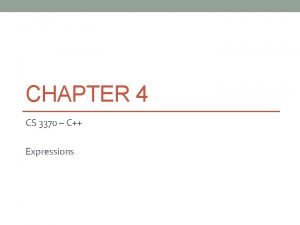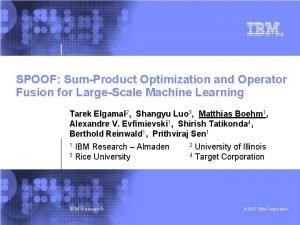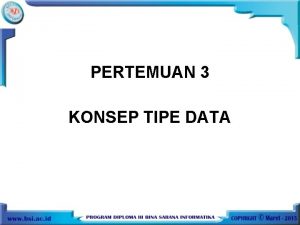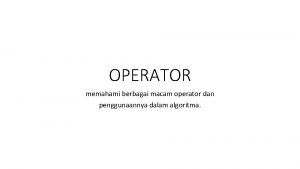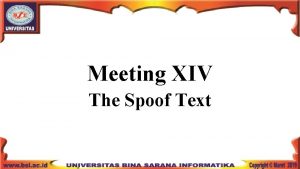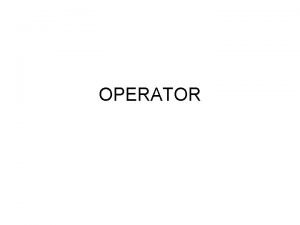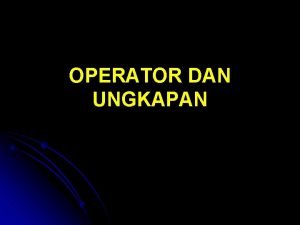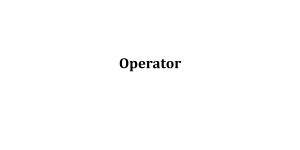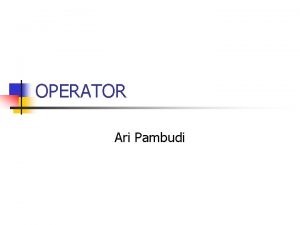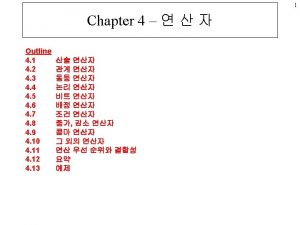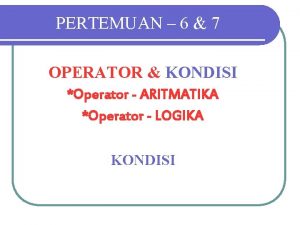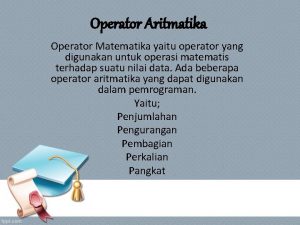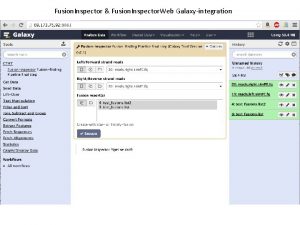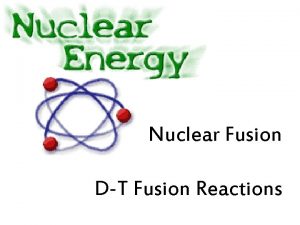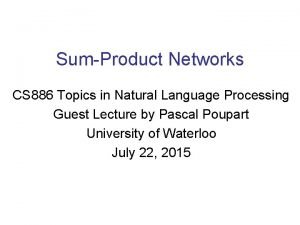SPOOF SumProduct Optimization and Operator Fusion for LargeScale
















- Slides: 16

SPOOF: Sum-Product Optimization and Operator Fusion for Large-Scale Machine Learning Tarek Elgamal 2, Shangyu Luo 3, Matthias Boehm 1, Alexandre V. Evfimievski 1, Shirish Tatikonda 4, Berthold Reinwald 1, Prithviraj Sen 1 1 IBM Research – Almaden 2 University of Illinois 3 Rice University 4 Target Corporation IBM Research © 2017 IBM Corporation

Motivation § Declarative Large-Scale Machine Learning (ML) – Simplify development / usage of ML tasks or algorithms – System. ML: High-level language data independence / plan generation – State-of-the-art compilers: rewrites, operator selection, fused operators § Ubiquitous Optimization Opportunities ┬ – Example Rewrites: – Example Fused operators: ┬ ┬ X y (y X) , sum(λ X) λ sum(X), ┬ trace(X Y) sum(X ʘ Y ) ┬ ┬ sum(X ʘ Y ʘ Z), X (X v), sum(X ʘ log(U V )) sum 1 st pass v * Z X * Y 2 IBM Research X sparsity exploitation 2 nd pass q ┬ X sum X * log UV ┬ © 2017 IBM Corporation

Motivation § Declarative Large-Scale Machine Learning (ML) – Simplify development / usage of ML tasks or algorithms – System. ML: High-level language data independence / plan generation – State-of-the-art compilers: rewrites, operator selection, fused operators § Ubiquitous Optimization Opportunities – Example Rewrites: ┬ ┬ ┬ X y (y X) , sum(λ X) λ sum(X), ┬ trace(X Y) sum(X ʘ Y ) ┬ ┬ – Example Fused operators: sum(X ʘ Y ʘ Z), X (X v), sum(X ʘ log(U V )) Fewer intermediates, fewer scans, sparsity exploitation, less compute § Problems and Challenges – Large Development Effort: number of patterns, multiple runtime back-ends, multiple formats and combinations (sparse/dense) – High Performance Impact: slightly changed patterns can render rewrites and fused operators inapplicable 3 IBM Research © 2017 IBM Corporation

Example PNMF – A 1000 x War Story § Poisson Nonnegative Matrix Factorization (PNMF) – X ≈ W H of low rank k; X: 200 K x 200 K, sp=0. 001 (480 MB) 1: 2: 3: 4: 5: 6: 7: 8: 9: 10: 11: 12: 13: X = read(". /input/X") k = 100; eps = 1 e-15; max_iter = 10; iter = 1; This PNMF W = rand(rows=nrow(X), cols=k, min=0, max=0. 025) It still takes forever script takes H = rand(rows=k, cols=ncol(X), min=0, max=0. 025) – btw, I changed it while ( iter < max_iter ) { >24 h H = (H*(t(W)%*%(X/(W%*%H+eps)))) (H*(t(W)%*%(X/(W%*%H)))) / t(col. Sums (W)); slightly W = (W*((X/(W%*%H+eps))%*%t(H))) (W*((X/(W%*%H))%*%t(H))) / t(row. Sums (H)); obj = sum(W%*%H) - sum(X*log(W%*%H+eps)); sum(X*log(W%*%H)); print ("iter=" + iter + " obj=" + obj); iter = iter + 1; Here is an interesting } rewrite: sum(W H) X sum * log WH write (W, ". /output/W"); col. Sums(W) row. Sums(H) write (H, ". /output/H"); The problem is W H (320 GB), but we could add sparsity-exploiting fused operators and rewrites and fused operators: 1000 x 4 IBM Research © 2017 IBM Corporation

Our Vision: Holistic Optimization Framework § SPOOF Compiler Framework – Automatic rewrite identification and operator fusion – Increased opportunities and side effects (CSE, rewrites fusion) – Key ideas: (1) break up LA operations into basic operators (in RA), (2) elementary sum-product and RA rewrites, and (3) fused operator generation Non-invasive integration into System. ML sum(W H) (X/(W H +ε))H 5 ┬ IBM Research col. Sums(W) * row. Sums(H) Op TMP 5 © 2017 IBM Corporation

Sum-Product Optimization § SP-Plan Representation: restricted relational algebra – Data: input matrices are relations of (i, j, v)-tuples (intermediates are tensors) – Basic operations: selection σ, extended projection Π, aggregation Γ, join ⨝ – Composite operations: e. g. , multiply Aij *i=k ∧ j=l Bkl : = Πi, j; a*b(Aija ⨝i=k ∧ j=l Bklb) addition Aij +i=k ∧ j=l Bkl : = Πi, j; a+b(Aija ⟗i=k ∧ j=l Bklb) – Two restrictions: a single value attribute per relation, and unique composite indexes per relation single value per tensor cell SP-Plan § Example SP Plan HOP DAG – sum(W H) 6 IBM Research © 2017 IBM Corporation

Sum-Product Optimization, cont. § Example SP Plan Rewrites But, SP opt alone can be counter-productive (e. g. , CSE ‘W H’) – W: = 200 K x 100, H: = 100 x 200 K Aggregation Sum-Product Elimination (distributive law) 8. 04 TFLOPs 7 IBM Research 8 TFLOPs 60 MFLOPs Sum-Product (distributive law) 40 MFLOPs © 2017 IBM Corporation

Operator Fusion § C-Plan Representation – Hybrid approach: hand-coded operator skeletons with custom body code Efficiency (data access, multi-threading) and flexibility – Template C-Nodes: generic fused operator skeletons (w/ data binding) e. g. , Spoof. Outer. Product, Spoof. Cellwise, Spoof. Row. Aggregate – Primitive C-Nodes: vector/scalar operations C-Plan HOP DAG § Example C-Plan ┬ – (X / (W H + ε)) H (PNMF update rule) 8 IBM Research © 2017 IBM Corporation

Operator Fusion, cont. § Example C-Plan Codegen – Recursive codegen on C-Plan – Generated operator inherits data access, multi-threading, etc from template skeleton 1: public final class TMP 5 extends Spoof. Outer. Product { 2: public TMP 5() { 3: _type = Outer. Product. Type. RIGHT; 4: } 5: protected void exec(double a, double [] b, int bi, 6: double [] c, int ci, . . . , double [] d, int di, int k) 7: { 8: double TMP 1 = dot. Product (b, c, bi, ci, k); // WH 9: double TMP 2 = TMP 1 + 1. 0 E-15; // +eps 10: double TMP 3 = a / TMP 2; // X/ 11: vect. Multiply. Add (TMP 3, c, d, ci, di, k); // t(H) 12: } 13: } 9 IBM Research Custom body code © 2017 IBM Corporation

Experimental Setting § Cluster Setup – 1 head node (2 x 4 Intel E 5530, 64 GB RAM), and 6 worker nodes (2 x 6 Intel E 5 -2440, 96 GB RAM, 12 x 2 TB disks) – Spark 1. 5. 2 with 6 executors (24 cores, 60 GB), 30 GB driver memory § ML Programs and Data – 3 full-fledged ML algorithms (PNMF, L 2 SVM, Mlogreg) – Synthetically generated data § Selected Baselines – Apache System. ML 0. 10 (May 2016): Base, Fused, SPOOF – Julia 0. 5 (Sep 2016) w/ LLVM-based just-in-time compiler 10 IBM Research © 2017 IBM Corporation

Micro Benchmarks: Operations Performance (@ single worker node) ┬ (X / (W H + ε)) H , (PNMF) 10 K x 10 K, k=100, Multi-threaded Sparsity-exploiting operators at 1/12 peak compute bandwidth 11 IBM Research sum(X ʘ Y ʘ Z), (L 2 SVM) dense, Multi-threaded Fused operator w/o intermediates at peak 1 xlocal / remote memory bandwidth (25 GB/s) © 2017 IBM Corporation

End-to-End Experiments: PNMF and LSVM § PNMF Execution Time (incl. compilation and I/O) – 20 iterations, rank k = 100 Dataset Base Fused SPOOF 10 K x 10 K, 0. 001 251 s 6 s 9 s 25 K x 25 K, 0. 001 4, 748 s 9 s 11 s 200 K x 200 K, 0. 001 >24 h 121 s 125 s § L 2 SVM Execution Time (incl. compilation and I/O) – 20 outer iterations, ε = 10 -14 12 Dataset Base Fused SPOOF 100 K x 10, 1. 0 (8 MB) 3 s 3 s 5 s 1 M x 10, 1. 0 (80 MB) 9 s 7 s 8 s 10 M x 10, 1. 0 (800 MB) 50 s 34 s 17 s 100 M x 10, 1. 0 (8 GB) 525 s 320 s 114 s IBM Research © 2017 IBM Corporation

Conclusions § Summary – SPOOF: Automatic rewrite identification and operator fusion – Non-invasive compiler/runtime integration into System. ML – Plan representation/compilation for sum-product and codegen § Conclusions and Future Work – Many rewrite/fusion opportunities with huge performance impact – Performance close to hand-coded ops w/ moderate compilation overhead – Future work: distributed operations, optimization algorithms § Available Open Source (soon) – SYSTEMML-448: Code Generation, experimental in 1. 0 release – Sum-product optimization and fusion optimizations later 13 IBM Research © 2017 IBM Corporation

System. ML is Open Source: Apache Incubator Project since 11/2015 Website: http: //systemml. apache. org/ Sources: https: //github. com/apache/incubator-systemml 14 IBM Research © 2017 IBM Corporation

Backup: Operator Fusion, cont. § Example C-Plan Codegen – L 2 SVM inner loop 1: 2: 3: 4: 5: 6: out = 1 - Y * (Xw + step_sz*Xd); sv = (out > 0); out = out * sv; g = wd+step_sz*dd - sum(out*Y*Xd); h = dd + sum(Xd*sv*Xd); step_sz = step_sz - g/h; 1: public final class TMP 2 extends Spoof. Cellwise { 2: 3: 4: 5: 6: 7: 8: 9: 10: 11: 12: 13: 14: 15: 16: 17: 18: 19: 20: } 15 public TMP 2() { _type = Cell. Type. FULL_AGG; } protected double exec(double a, double [][] vectors, double [] scalars, . . , int row. Index) { double TMP 3 = vectors[1][row. Index]; double TMP 4 = vectors[0][row. Index]; double TMP 5 = a * scalars[0]; double TMP 6 = TMP 4 + TMP 5; double TMP 7 = TMP 3 * TMP 6; double TMP 8 = 1 - TMP 7; double TMP 9 = (TMP 8 > 0) ? 1 : 0; double TMP 10 = TMP 8 * TMP 9; double TMP 11 = TMP 10 * TMP 3; double TMP 12 = TMP 11 * a; return TMP 12; } # Intermediates: Base: 10, Fused: 5, Spoof: 0 IBM Research © 2017 IBM Corporation

Backup: Plan Caching Effects for Mlogreg § Dynamic Recompilation – Problem of unknown or changing sizes (e. g. , UDFs, data-dep. ops, size expr. ) – Integration of Spoof into dynamic recompiler huge compilation overhead Plan cache: reuse compiled ops across DAGs / recompilations § Mlogreg Cache Statistics – 500 K x 200 (800 MB), 20/5 outer/inner iterations, ε = 10 -14 – CSLH: Context-sensitive literal heuristic 16 Statistic Spoof no PC Spoof constant PC Spoof CSLH Execution time 49. 29 s 19. 87 s 14. 48 s PC hit rates 0 / 462 388 / 462 449 / 462 Javac compile time (sync) 34. 45 s 6. 88 s 1. 97 s JIT compile time (async) 25. 36 s 18. 84 s 10. 50 s IBM Research © 2017 IBM Corporation
 Spoof guard
Spoof guard Nike ad alexander the great
Nike ad alexander the great Example of spoof text
Example of spoof text How to make a spoof ad
How to make a spoof ad Generic structure of spoof text
Generic structure of spoof text Ettercap port stealing
Ettercap port stealing Unary and binary operators
Unary and binary operators Operator fusion deep learning
Operator fusion deep learning Tipe data int mempunyai ukuran
Tipe data int mempunyai ukuran Pada tipe data boolean berlaku operator-operator
Pada tipe data boolean berlaku operator-operator Logical operators priority in c
Logical operators priority in c Kontinuitetshantering
Kontinuitetshantering Novell typiska drag
Novell typiska drag Nationell inriktning för artificiell intelligens
Nationell inriktning för artificiell intelligens Ekologiskt fotavtryck
Ekologiskt fotavtryck Varför kallas perioden 1918-1939 för mellankrigstiden
Varför kallas perioden 1918-1939 för mellankrigstiden En lathund för arbete med kontinuitetshantering
En lathund för arbete med kontinuitetshantering






